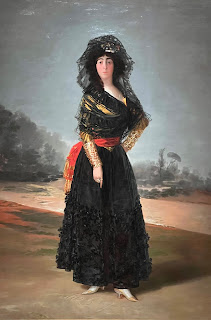Hispanic Art at the Royal Academy: Goya Portraits
Goya (1746-1828) lived through especially tricky times in Spain – the Enlightenment, then invasion and brutal war, a brief interval of liberalism, followed by reactionary despotism.
Throughout his career, until voluntary exile at the end, he was part of the Spanish artistic and social establishment, negotiating these upheavals. (Unlike many artists he enjoyed contemporary rather than posthumous success.) But this meant that he had, to an extent, to split his artistic persona, treating differently the commissions that came with his public role as a court painter, and the subjects that were dearer to his private heart.
The divide is particularly clear in Goya’s portraits.
Goya had politically liberal sympathies. He embraced the C18 Enlightenment. Even though Spain was a monarchy, King Charles IV was tolerant and allowed liberal ideas to flourish (this may have been because he wasn’t particularly bright, and more interested in hunting than politics and philosophy)). Goya had to paint many people of royalty or aristocracy for whom he felt little admiration or even contempt.
Goya managed these dilemmas with subtlety, using the general truth that people see what they want to see. His portraits of the Great and Good give the Great and Good plenty of haughty grandeur, which presumably satisfied his subjects. They had no eye for what Goya also conveys: pomposity, vanity, stupidity – cruelty even.
Look at the portrait of the repressive King Ferdinand, restored to the Spanish throne after the final defeat of Napoleon. He tore up the liberal constitution of 1812 and reinstated the Inquisition. He claimed absolute power. Goya has him richly costumed and regally haughty. But he is also depicted, form another viewpoint, as a weak faced blob on top of a mountain of white and crimson..
In utter contrast, Goya’s portraits of friends and family are done with wonderful sensitivity, displaying the humanity of both subject and artist. Consider this portrait of an unidentified friend:
In the Hispanic Exhibition, there are two examples of these different strands. There’s the deeply felt portrait of Goya’s friend, Pedro Mocarte, probably after he was afflicted by the illness that ended his professional musical career.
Then there is the young popinjay of a military officer, painted because of his aristocratic connections. Goya gives him the surface appearance of a smart young army man. But critical viewers can detect uncertainty, perhaps even the bogus (is this youth really to lead men in battle?).
There is a third strand beside the other two. The Duchess of Alba. Her portrait is like none other. From a distance, the painting projects imperiousness and beauty, not at all slyly subverted, but hardly delicately intimate. This woman challenges the whole world with her gaze.
There has always been speculation about the relationship between the Duchess and Goya. They were certainly friends, and Goya lived in her household for a time. But this portrait is not, I suggest, one of passion given and returned. Rather, the bold figure of the Duchess is implying “If you worship me, be at my feet, but don’t expect to worship you in return”. Of course. Goya may betray his unreturned infatuation by precisely claiming that place at her feet, with his painted signature in the sand “Solo Goya” – only Goya..
The painting is wonderfully unsettling but not in any cruel way. If Goya loved the Duchess, but she didn’t love him, that has not diminished Goya’s admiration for this imperious muse.
March 2023







No comments:
Post a Comment